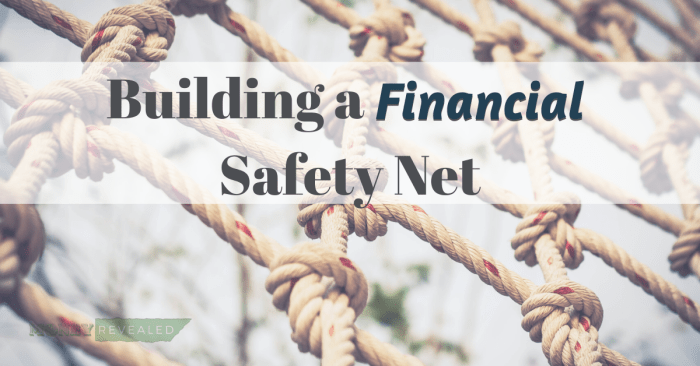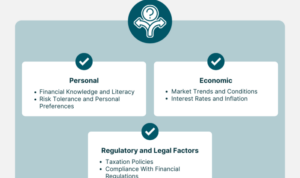Yo, diving into the world of Building a financial safety net, where we break down the key steps to securing your financial future. From emergency funds to investment strategies, we got you covered with all the deets you need to know.
Importance of Building a Financial Safety Net
Building a financial safety net is crucial for individuals to provide a sense of security and stability in times of need. It acts as a cushion to protect against unexpected financial setbacks, ensuring that you are prepared for any emergencies that may arise.
Benefits of Having a Financial Safety Net
- Peace of mind: Knowing you have a financial safety net in place can reduce stress and anxiety about potential financial crises.
- Ability to handle emergencies: Whether it’s a medical expense, car repair, or job loss, having savings set aside can help you navigate through tough times without going into debt.
- Flexibility and freedom: With a financial safety net, you have the ability to make choices based on what’s best for you and your family without being constrained by financial limitations.
Examples of Situations Where a Financial Safety Net is Essential
- Unexpected medical expenses: A sudden illness or injury can lead to hefty medical bills. Having a financial safety net can help cover these costs without putting a strain on your finances.
- Job loss: Losing your job unexpectedly can be a major blow to your income. With a financial safety net, you can maintain your lifestyle while searching for a new job without worrying about immediate financial obligations.
- Natural disasters: In the event of a natural disaster like a hurricane or earthquake, having funds set aside can help you rebuild and recover without relying solely on insurance or government assistance.
Budgeting and Saving Techniques
Effective budgeting and saving techniques are essential for individuals to build a strong financial safety net. By properly managing finances and setting aside money for emergencies, individuals can protect themselves from unexpected financial hardships.
Allocate Funds Wisely
- Create a monthly budget outlining income and expenses.
- Identify areas where expenses can be reduced to increase savings.
- Allocate a portion of income towards building the financial safety net.
Different Saving Techniques
- Automate savings by setting up recurring transfers to a separate savings account.
- Utilize savings apps or tools to track progress towards savings goals.
- Consider using the envelope system to allocate cash for different expenses.
Short-term vs. Long-term Saving Strategies
- Short-term saving strategies focus on building an emergency fund for immediate financial needs.
- Long-term saving strategies involve investments and retirement accounts for future financial security.
- Balancing short-term and long-term saving goals is crucial for a well-rounded financial safety net.
Insurance Coverage
Insurance plays a crucial role in building a solid financial safety net by providing protection against unexpected events that could lead to financial hardship. Various types of insurance products can contribute to this safety net, including health, life, and disability insurance.
Types of Insurance Products
- Health Insurance: Helps cover medical expenses in case of illness or injury, reducing the financial burden on individuals and families.
- Life Insurance: Provides a payout to beneficiaries upon the policyholder’s death, ensuring financial stability for loved ones in the event of a tragedy.
- Disability Insurance: Offers income protection if a person becomes unable to work due to a disability, ensuring continued financial support.
Importance of Reviewing and Updating Insurance Coverage
Regularly reviewing and updating insurance coverage is essential to ensure that the policies are adequate to meet current needs and circumstances. Life changes such as marriage, having children, or starting a business may require adjustments to insurance coverage to maintain financial security.
Investment Strategies for Financial Stability

Investing is a key component of building a strong financial safety net. By exploring various investment options, individuals can enhance their financial stability in the long run.
Diversification of Investment Portfolio
Diversifying your investment portfolio is crucial for mitigating risks and maximizing returns. By spreading your investments across different asset classes such as stocks, bonds, real estate, and commodities, you can reduce the impact of market fluctuations on your overall portfolio. This strategy helps in achieving a balance between risk and reward.
- Stocks: Investing in individual stocks or exchange-traded funds (ETFs) can provide potential for high returns but come with higher risks. It is important to research and select companies with strong fundamentals and growth potential.
- Bonds: Bonds are considered safer investments compared to stocks as they offer fixed interest payments. Treasury bonds, municipal bonds, and corporate bonds are common options for investors looking for income stability.
- Real Estate: Investing in real estate properties can generate rental income and long-term appreciation. Real estate investment trusts (REITs) are another option for passive real estate investment.
- Commodities: Investing in commodities like gold, silver, oil, or agricultural products can provide diversification and act as a hedge against inflation and economic uncertainties.
Remember, a well-diversified portfolio can help you weather market volatility and achieve consistent growth over time.
Long-Term vs. Short-Term Investments
When building a financial safety net, it is essential to consider your investment horizon and goals. Long-term investments, such as retirement accounts like 401(k) or Individual Retirement Accounts (IRAs), offer tax advantages and compound interest over time. On the other hand, short-term investments like certificates of deposit (CDs) or money market accounts provide liquidity but may offer lower returns.
- Long-Term Investments: Focus on strategies that align with your long-term financial objectives, such as saving for retirement or education. Consider dollar-cost averaging to invest regularly regardless of market conditions.
- Short-Term Investments: Keep a portion of your portfolio in liquid assets for emergencies or short-term financial goals. Explore options like high-yield savings accounts or short-term bonds for quick access to cash.
Risk Management and Monitoring
It is important to regularly review and rebalance your investment portfolio to maintain the desired asset allocation and risk level. Consider working with a financial advisor to create a personalized investment plan that aligns with your risk tolerance and financial goals. Monitor market trends, economic indicators, and geopolitical events that may impact your investments, and make adjustments when necessary.
- Risk Assessment: Understand your risk tolerance and investment objectives to create a balanced portfolio that suits your financial situation.
- Monitoring and Rebalancing: Regularly review your investments and make adjustments to ensure they remain in line with your long-term goals. Rebalance your portfolio periodically to maintain diversification and manage risk effectively.






